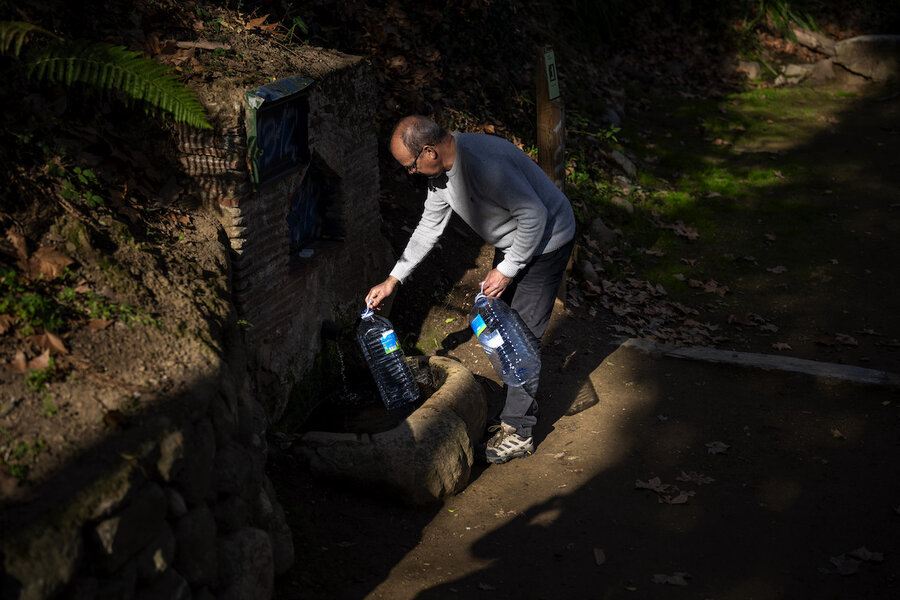Winter drought: Drinking water runs dry in northern Spain
Loading...
| Gualba, Spain
Plastic jugs in hand, Joan Torrent takes a path into the woods in search of drinking water. He fills them at a natural spring and then hauls them back to his home in Gualba, a picturesque village near Barcelona that like many towns in Spain is bearing the worst of a record drought.
For Mr. Torrent, making this walk for water several times a week with the 2-gallon jugs is a minor inconvenience, but one that may become more common as Spain and the rest of the Mediterranean adapt to climate change.
“Gualba used to be full of springs. Now I think this is the only one left,” Mr. Torrent, a retiree, said while making his way to the fountain connected to the spring. “I don’t think we are aware of what is in store for all of us ... people don’t want to hear about there being a lack of water.”
Officials in Spain’s northeast region of Catalonia declared a drought emergency Feb. 1, with reservoirs that serve 6 million people, including the population of Barcelona, at under 16% of their capacity, a historic low.
The emergency, which takes effect Feb. 2, limits daily amounts of water allowed for residential and municipal purposes to 200 liters (53 gallons) per person. Catalonia’s water agency says the average resident uses 116 liters (30 gallons) a day at home.
“We are entering a new climate reality,” Catalan regional president Pere Aragonès said on announcing the emergency. “It is more than likely we will see more droughts that will be both more intense and more frequent.”
However, Gualba and other small towns and villages across Catalonia’s countryside have been in crisis mode for months. So while Barcelona’s population has yet to feel the drought’s impact beyond not being able to fill up private pools and wash cars, thousands living in small communities that depend on wells now running dry are experiencing difficulties getting water fit for consumption.
Gualba’s name, according to local lore, means “white water” – for the streams flowing down from the Montseny Mountain overlooking the village. The village of around 1,500 residents has been without drinking water since December, when the local reservoir fell so low that water became undrinkable and only good for washing clothes and dishes.
Most residents have to drive to another town to buy bottled water.
“We have always had abundant water,” said Jordi Esmaindia, deputy mayor of Gualba. “Nobody imagined we would be like this.”
Spain has seen three years of below-average rainfall amid record high temperatures, and conditions are only expected to get worse because of climate change, which is predicted to heat up the Mediterranean area faster than other regions.
The reservoirs fed by the Ter and Llobregat rivers in northern Catalonia have fallen to 15.8% of their capacity, while their 10-year average is 70%. Only the Guadalete-Barbate river basin in southern Andalusia, which faces similar shortages and restrictions, is worse off, at 14.6%.
Barcelona has avoided water shortages thanks to boosting its costly desalination and water purifying systems, which now account for 55% of all water use in Catalonia. Even so, regional authorities in Barcelona and Sevilla, the seat of southern Andalusia, are both thinking of having drinking water shipped in.
Catalan authorities in Barcelona are threatening to fine municipalities if their residents, farmers, and businesses don’t meet the water restrictions. They are also urging them to raise water bills so they can pay to modernize pipes.
“Some municipalities lose 70-80% of their water through leaks,” Catalan government official Laura Vilagrà told Spanish national radio RNE. “That is not sustainable.”
Experts in water management fear the countryside will continue to suffer the most. The restrictions have slashed water for pigs and other herd animals to 50% and for crop irrigation by 80% – a big blow to the rural economy.
“It is telling that this drought makes headlines simply because it affects Barcelona … when we have villages in the Pyrenees that have endured water shortages and have needed to get water brought in by truck for several months,” said Dante Maschio, spokesman for the Catalan nonprofit Aigua és vida, or Water Is Life organization.
“If the drought is not managed correctly, it can lead to greater inequality and tension between cities and rural areas,” Mr. Maschio said.
Many towns are having water brought by tanker trucks often at huge expense. Catalonia’s government has shared $4.3 million (4 million euros) – of a total of $206 million (191 million euros) dedicated to fighting the drought – among 213 municipalities to help pay for transporting water.
Still, some towns have to cut off the taps, like Espluga de Francolí, which shuts off the water supply daily from 8 p.m. until 10 a.m. to allow its wells to recover overnight.
Eva Martínez is mayor of Vallirana, a town of 15,000 just over a half-hour west of Barcelona. For months now, her municipality has had periods when it has had to bring in water by trucks, which park in neighborhoods for residents to fill up bottles and buckets.
“We understand that it is frustrating for citizens when we have problems with water and when we cannot provide water in the quantity and quality that is required,” Ms. Martínez said. “We see that it does not rain. The situation is desperate.”
This story was reported by The Associated Press. AP writer Renata Brito contributed to this report.







